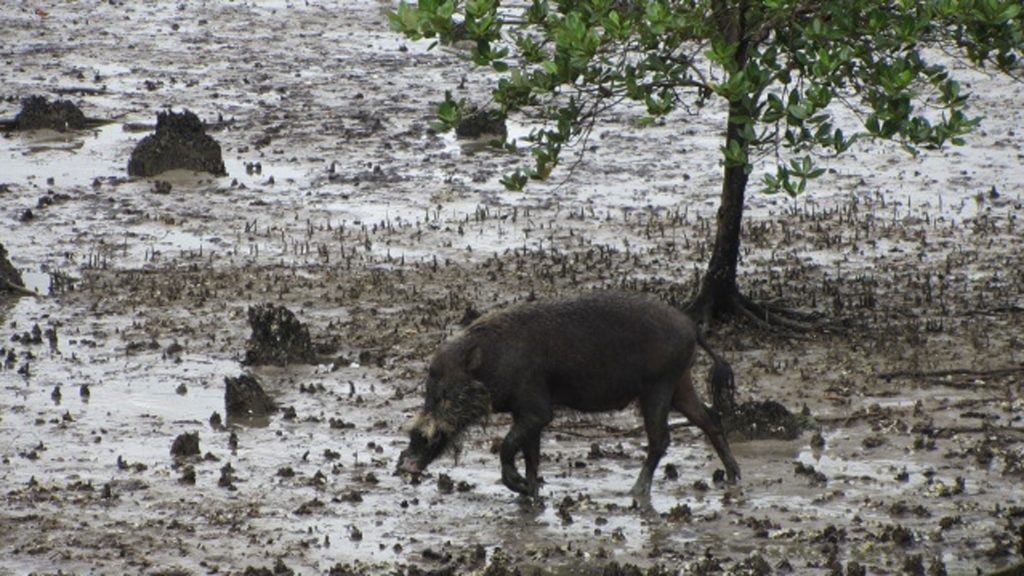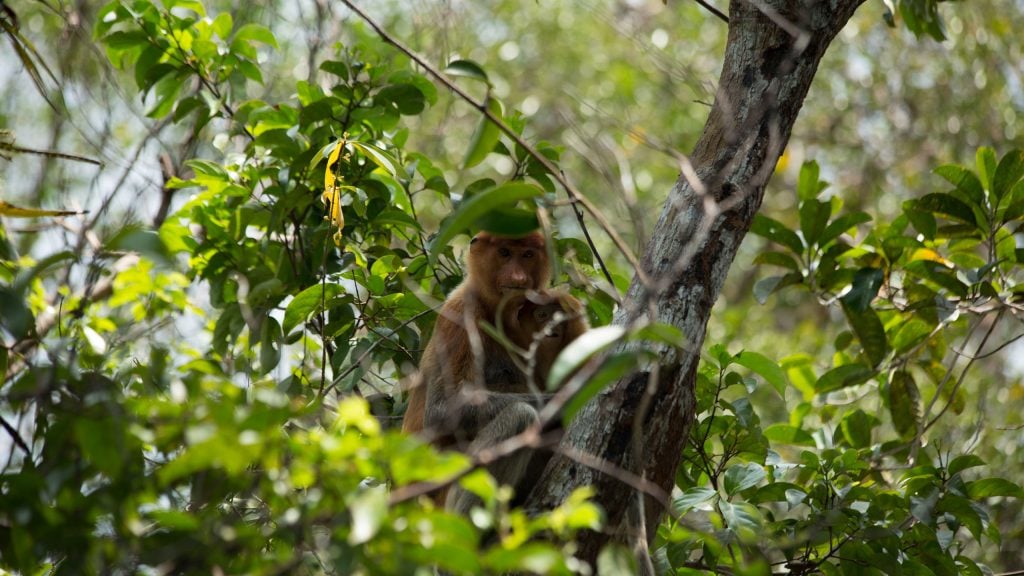Published on: August 1st, 2017
Last updated: March 8th, 2024
On her recent trip to Borneo, Esme Fox was surprised to find that it was not the famous orangutans, but the nasally-endowed proboscis monkeys that most piqued her interest.
I had wanted to visit the rainforest-clad island of Borneo to spot the orangutans for as long as I could remember – so, when I discovered that it was just a short flight from my base for a few months, Penang in Malaysia, I jumped at the chance to visit.
Though I did see the orangutans, the highlight of my trip turned out to be a species I had known little about and had only seen photos of once or twice: the odd-looking proboscis monkeys.
The way to Bako National Park
I was staying in the capital of the Sarawak region of Malaysian Borneo, the city of Kuching, a great base for wildlife watching with easy access to both the Semmengoh Nature Reserve, home of the orangutans, and Bako National Park, where the proboscis monkeys reside.
Proboscis monkeys are endemic to Borneo, the only place they are found outside captivity. They live around rivers, coastal mangrove areas and swamps, and are highly endangered – there are thought to be only around 7,000 left in the wild.
To reach Bako National Park, I took an hour’s bus ride from the city, followed by a half-hour boat journey along a wide river estuary to meet the sea and the peninsular national park. Soon, I was speeding down the muddy river, which was lined with colourful wooden houses, out into the open sea.
I had been told that the Bornean river estuaries are home to the endangered Irrawaddy river dolphins, so I kept my gaze fixed on the water. But the recent rain storms meant that the water had been churned up into a thick, chocolate-like soup. I hoped that the rains wouldn’t affect my chances of seeing the proboscis monkeys, too.
As the tide was still out, the boat moored a few metres from the beach and I had to wade through the water towards the beach. To one end lay a mangrove swamp, to the other, huge sandstone boulders, and in the middle, vast swatches of golden sand. I made my way ashore barefoot and carrying all my belongings, feeling like I’d just been abandoned on a paradisiacal, desert island.
Through a small opening in the trees at the back of the beach, I found the park headquarters and my accommodation for the night: a wooden hut surrounded by forest and set high above the swampy water on a series of timber walkways. It was very basic and slightly damp, but it was the only accommodation option in the whole of Bako National Park and it was worth staying the night.
Wildlife encounters in the rainforest
I wanted to get in a nature hike and some wildlife spotting before sundown, so I headed out almost immediately. Passing the main block and the canteen, I saw a few people staring up into a tree, so I moved closer to take a look. There at the top of a tree, was a proboscis monkey, stuffing leaves into his mouth.
I couldn’t believe that I’d found one already. He was a large male, with a giant comical nose taking centre stage in the middle of his face and a huge pot belly. Male proboscis monkeys grow up to 2.5 feet tall and weigh around 20 kilograms. This was no small, graceful monkey, swinging delicately from tree to tree; this was a huge creature that crashed noisily from branch to branch, making the entire tree sway back and forth.
He was mesmerising to watch, so humanlike were his mannerisms and facial expressions (made even more apparent by the fact that proboscis monkeys’ faces are covered with skin instead of fur). I could have stayed watching him right there until sundown.
Shortly, a crowd gathered below, so I decided to continue my hike. I took the Telok Paku route, favoured by the proboscis monkeys because it runs atop the foliage-covered rocks that hug the shoreline and ends at a secluded beach. Crossing the walkways over the mangroves, I saw many small, furry, brown macaques, as well as wild bearded pigs snuffling around in the mud. Climbing up wooden steps, scrambling over giant rocks and carefully stepping over mazes of tree roots, I made my way higher and higher, keeping my eyes peeled for wildlife at every step of the way. After two hours continuing in this manner, the pathway wound its way down towards the sea and I found myself at a small wooden hut on the beach.
I recognised a friendly Malaysian couple from the boat waving at me from the hut. “You just missed one,” they called out. “There was a proboscis monkey sitting on the beach here, just before you arrived”. I couldn’t believe I’d hiked all that way without seeing any in the rainforest and had now just missed one by minutes. I was disappointed, but not knowing when they would appear and being able to venture out on your own to find them was all part of the thrill of finally seeing the monkeys in the wild.
The beach monkeys
The next morning, after an early hike in a torrential downpour where I hadn’t seen a thing, I had still only spotted that one proboscis monkey by the canteen. After drying off and checking out of my accommodation, I only had a few hours left before the boat would arrive to take me back. Not feeling like another strenuous hike, I decided instead to amble along the vast sandy beach instead.
I hadn’t gone far, when there, sunning themselves on the sand, the breeze blowing their blond fur, was a family of proboscis monkeys: the huge male with his bulbous nose, the female with her pert, little, pointy one, and a small baby clinging tightly to his mother’s stomach. I learned later that the proboscis monkeys are the planet’s best primate swimmers and have even developed webbed feet. Perhaps that’s why they liked hanging out on the beach, rather than in the trees above.
They studied me as I approached and soon retreated to the treetops, where they could watch, curiously, from a safe distance. Not seeming upset by my presence, the parents set about munching with an air of nonchalance, as the baby peered down inquisitively at me from between the leaves. I walked alongside the family as they jumped from tree to tree for the best part of an hour, disturbed by nothing but the soft sshhhh of the waves along the shore, until they finally slunk away into the rainforest above.
Dwarfed by towering boulders and limestone cliffs, I wandered around the beach for a little longer, until I could see the boats return to the shore. I grabbed my backpack and shoes and waded into the water to meet them. I couldn’t help the sense of awe I felt watching Bako sink away into the distance. This was exactly the Borneo I had imagined – albeit featuring a different primate.


















